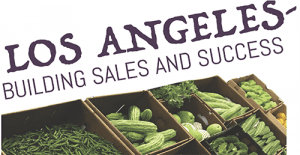With the economy strong, Los Angeles wholesalers often order more than they need and wind up with bigger surpluses.

Also, when business is booming, customers request better, more perfect produce, so far more fruits and vegetables end up in the “ugly” or seconds category. Meanwhile, there are needy individuals throughout Southern California.
Enter Food Forward. Founded in 2014, the nonprofit is arguably America’s largest surplus produce recovery organization and projected to feed 1.75 million needy Southern Californians in 2018. In 2017, Food Forward’s wholesale recovery division collected 17.4 million pounds of surplus produce. The group accomplishes this with three drivers averaging five to eight loads, totaling 50 to 75 tons daily.
Just as with for-profit businesses, soliciting donations is a matter of meeting people and building relationships.
“I always look for arrangements that benefit donors,” explains Luis Yetiz, wholesale market manager. “In the beginning, every morning I would go to the market and shake everyone’s hand, whether they had something to donate or not. Then as now, I try to make sure I help them.
“With the cost of trash service rising, a big incentive for donors is saving money on storage and disposal fees,” says Yetiz. “Landfill rates are $45 to $50 per ton and that doesn’t include fuel, transportation, etc. Surplus produce is not considered compostable because of wax and cardboard packaging. By donating to Food Forward, wholesalers are saving money. Even if the produce is not suitable for the food pantries, we find pig or goat farms who’ll take it.”
In its early days, Yetiz says, Food Forward was “picking up the produce and immediately delivering it to small to mid-sized foodbanks.”
In the years since, volume has picked up considerably. “Now we’re working with larger foodbanks including over 575 agencies serving people in need in Los Angeles, Ventura, Santa Barbara, Orange, San Bernardino, San Diego, Imperial, and Riverside Counties.”
The recipients of the donated food vary, and one in particular is a bit ironic. “The end users are immigrant families, people with AIDS, the elderly, farm workers, homeless — no one gets rejected.”
It’s important to point out that any produce distributed to the needy still has to have some remaining shelf life. For example, bananas, oranges, apples, potatoes, and onions are always welcome. Items like strawberries usually aren’t salvageable nor is lettuce, unless it is packaged. Surplus avocados are especially appreciated, though supply fluctuates with availability and pricing. In many cases, “ugly” avocados are processed into guacamole and other products.
Fortunately for those who depend on Food Forward and its wealth of fruits and vegetables, there are plenty of companies that contribute. “We work with 300 donors, so we’re usually able to obtain all the favorites,” Yetiz says, “but we could always use more.”
This is an excerpt from the most recent Produce Blueprints quarterly journal. Click here to read the full article.


